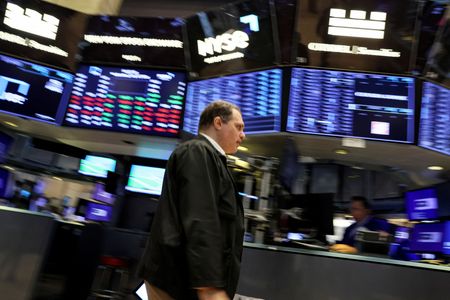
By Stephen Culp
NEW YORK (Reuters) – Wall Street see-sawed and crude prices plunged on Monday as world factory data showed demand weakening under inflation pressures, while the looming possibility of recession curbed risk appetite.
All three major U.S. indexes were last modestly lower on the first day of August, coming on the heels of the S&P 500’s and the Nasdaq’s biggest monthly percentage gains since 2020.
“It seems like a day of rest, a breathing day,” said Peter Tuz, president of Chase Investment Counsel in Charlottesville, Virginia. “It’s the first day of a new month and the markets did great in July.”
“There’s little conviction in either direction right now.”
The Institute for Supply Management’s (ISM) purchasing managers’ index (PMI) showed U.S. factory activity decelerated in July to its lowest level since August 2020, but remained in expansion territory and long-running supply restraints appeared to be easing.
The report follows a swath of data from Europe and Asia that showed factory activity slowing or contracting in the face of dampened global demand and persistent inflation.
“Whether we’re in technical recession or not, we’re seeing global softening,” Tuz said, adding that “there seems to be light at the end of the inflation tunnel.”
The Dow Jones Industrial Average fell 63.95 points, or 0.19%, to 32,781.18, the S&P 500 lost 14.53 points, or 0.35%, to 4,115.76 and the Nasdaq Composite dropped 25.85 points, or 0.21%, to 12,364.84.
Energy stocks pulled European stocks into the red as fears of weakening demand and economic contraction on the heels of disappointing data from the euro zone and China.
The pan-European STOXX 600 index lost 0.19% and MSCI’s gauge of stocks across the globe shed 0.02%.
Emerging market stocks lost 0.06%. MSCI’s broadest index of Asia-Pacific shares outside Japan closed 0.08% higher, while Japan’s Nikkei rose 0.69%.
Crude prices headed lower as global factory data weighed on the demand outlook, and as market participants braced for this week’s meeting of OPEC and other oil producers concerning world crude supply.
U.S. crude fell 4.73% to settle at 93.89$ per barrel, and Brent settled at $100.03 per barrel, down 3.94% on the day.
U.S. Treasury yields slid in choppy trading as economic data continued to hint at an impending slowdown which could prompt the Federal Reserve to slow the pace of interest rate increases.
Benchmark 10-year notes last rose 9/32 in price to yield 2.6091%, from 2.642% late on Friday.
The 30-year bond last rose 29/32 in price to yield 2.9302%, from 2.977% late on Friday.
The dollar touched its lowest level against the Japanese Yen since last June and the dollar index, which measures its performance against a basket of world currencies, was volatile in the wake of the PMI data.
The dollar index fell 0.4%, with the euro up 0.31% to $1.025.
The Japanese yen strengthened 0.97% against the dollar to 131.95, while sterling was last trading at $1.2247, up 0.67% on the day.
Gold prices edged higher as the dollar softened, as investors looked to economic data for clues regarding the pace of interest rate hikes from the U.S. Federal Reserve.
Spot gold added 0.2% to $1,768.73 an ounce.
(Reporting by Stephen Culp; Additional reporting by Carolyn Cohn in London and Bansari Kamdar in Bangalore; Editing by David Holmes and Tomasz Janowski)

